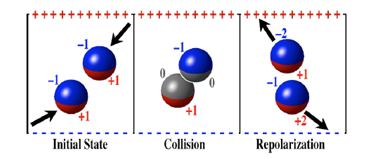How Sandstorms Generate Spectacular Lightning Displays
One of the fascinating features of volcanic cloud plumes is the extraordinary displays of lightning they generate. Similar discharges occur in sandstorms and in the dust blown up by helicopters flying over deserts causing dangerous arcing. These lightning storms are as puzzling as they are spectacular.

There are two parts to the problem. First, particles of sand are more or less identical, in size shape and chemistry. How then do they transfer charge between them? Second, sand particles are insulators, not conductors, which makes it doubly strange that they can be involved in the transfer of such massive amounts of charge. What on Earth is going on?
Today, Thomas Pähtz at the Swiss Federal Institute of Technology in Zurich and a couple of buddies say they can explain the whole thing with a deceptively simple new model. What’s more, their model makes some straightforward predictions about the way sand particles transfer charge.
Here’s their idea. They begin by thinking of sand particles as identical dielectric spheres. In an electric field, dielectric particles become polarised, causing charge to gather on each side of the sand spheres. When two spheres touch, the charge redistributes across the boundary between them, creating a larger, doubly polarised particle. The key idea is what happens when this breaks into two again: each particle ends up with a net charge (see picture above). The process of polarisation then begins again allowing the particles to increase their charge even further with each collision. It’s not hard to see how a relatively small number of collisions could end up transferring huge amounts of charge in this way despite the absence of any kind of conducting medium.
This model makes some interesting predictions about the rate at which a cloud of sand should pump charge. For example, it predicts that shallow clouds of dust would end up being charged only weakly. This is what you might expect from weak winds or heavy grains. Similarly, very thick clouds should result only in weak charging. However, Pahtz and co says that in intermediate clouds, there should be dramatic charging. And sure enough, that’s exactly what they find, both in numerical simulations of dust clouds and in actual experiments they’ve performed with real sand.
“We find as predicted that shallow agitated beds - as could be expected in weak winds or for heavy grains - charge weakly, as do very deep agitated beds - as would be expected for highly dissipative materials. Under intermediate conditions, however, we observe dramatic charging, with the most highly charged particles found preferentially near the top of the agitated bed,” they say.
That’s an elegant idea that produces some fascinating results. But it leaves open one very important question. In real storms, what generates the electric field that polarises the sand particles in the first place? It looks like Pahtz and co will have interesting time ahead getting to the bottom of that one.
Ref: http://arxiv.org/abs/1003.5188 Why do Particle Clouds Generate Electric Charges?
Keep Reading
Most Popular
Large language models can do jaw-dropping things. But nobody knows exactly why.
And that's a problem. Figuring it out is one of the biggest scientific puzzles of our time and a crucial step towards controlling more powerful future models.
The problem with plug-in hybrids? Their drivers.
Plug-in hybrids are often sold as a transition to EVs, but new data from Europe shows we’re still underestimating the emissions they produce.
Google DeepMind’s new generative model makes Super Mario–like games from scratch
Genie learns how to control games by watching hours and hours of video. It could help train next-gen robots too.
How scientists traced a mysterious covid case back to six toilets
When wastewater surveillance turns into a hunt for a single infected individual, the ethics get tricky.
Stay connected
Get the latest updates from
MIT Technology Review
Discover special offers, top stories, upcoming events, and more.